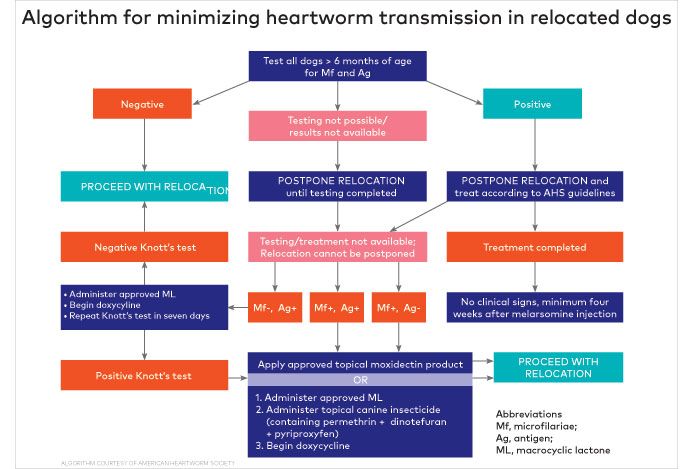AHS introduces algorithm to minimize heartworm transmission in relocated dogs
In wake of 2017s multiple natural disasters, heartworm society offers guidelines for testing, treatment and prevention before pets are transported out of their current state.

The new guidelines include an algorithm for treatment.
The American Heartworm Society (AHS) has announced a new set of best practices for minimizing heartworm transmission in relocated dogs, including recommendations for testing, treatment and prevention, that were developed in collaboration with the Association of Shelter Veterinarians (ASV), according to a society release.
These guidelines are intended to help in situations such as newly adopted pets left homeless by a recent hurricane, the dog that moved cross-country with its family or the canine companion that's returning from a beach vacation-situations the society says are familiar to veterinarians in today's mobile society.
“Preventing transmission of D[irofilaria] immitis has always been a focus of the AHS heartworm guidelines. However, we believe we need to do more given the potential for heartworm-positive dogs to serve as reservoirs for infection,” says AHS President Chris Rehm, DVM, in the release. “For example, if a microfilaria-positive dog is rescued in one state and subsequently moved to a new home in another state where nearby pets are unprotected, mosquitoes feeding on the new dog can quickly become heartworm vectors. The results can be disastrous for unprotected pets in the vicinity.”
While the ideal scenario is to treat infected dogs before transporting or traveling with them, situations often dictate that infected animals can't undergo a full course of heartworm treatment, including adulticide administration, before hitting the road, the release states. The goals of the AHS transportation guidelines are to prevent infected dogs from becoming heartworm reservoirs, ensure that untimely travel doesn't trigger heartworm disease complications, and ensure that, once treated, dogs are on lifelong heartworm prevention. These guidelines are also an algorithm to decide best course of treatment for a pet.
Best practices include the following steps:
> Testing all dogs 6 months of age or older before relocation
> Delaying relocation of heartworm-positive dogs
> Pretreating heartworm-positive dogs (e.g. administering macrocyclic lactone drugs, applying an EPA-approved product that kills and repels mosquitoes, and administering antibiotics) when relocation can't be delayed
> Following guidelines for microfilaria testing and retesting to avoid transportation of microfilaremic dogs
> Following guidelines for transport after administration of melarsomine to infected dogs.
“It is clear that care, cooperation and communication are needed on both ends of any journey that involves a heartworm-positive dog,” Dr. Rehm states. “Our goal is to help veterinarians who oversee the health of both traveling and adopted dogs-as well as their clients-understand the threat and make the prevention of heartworm transmission a priority.